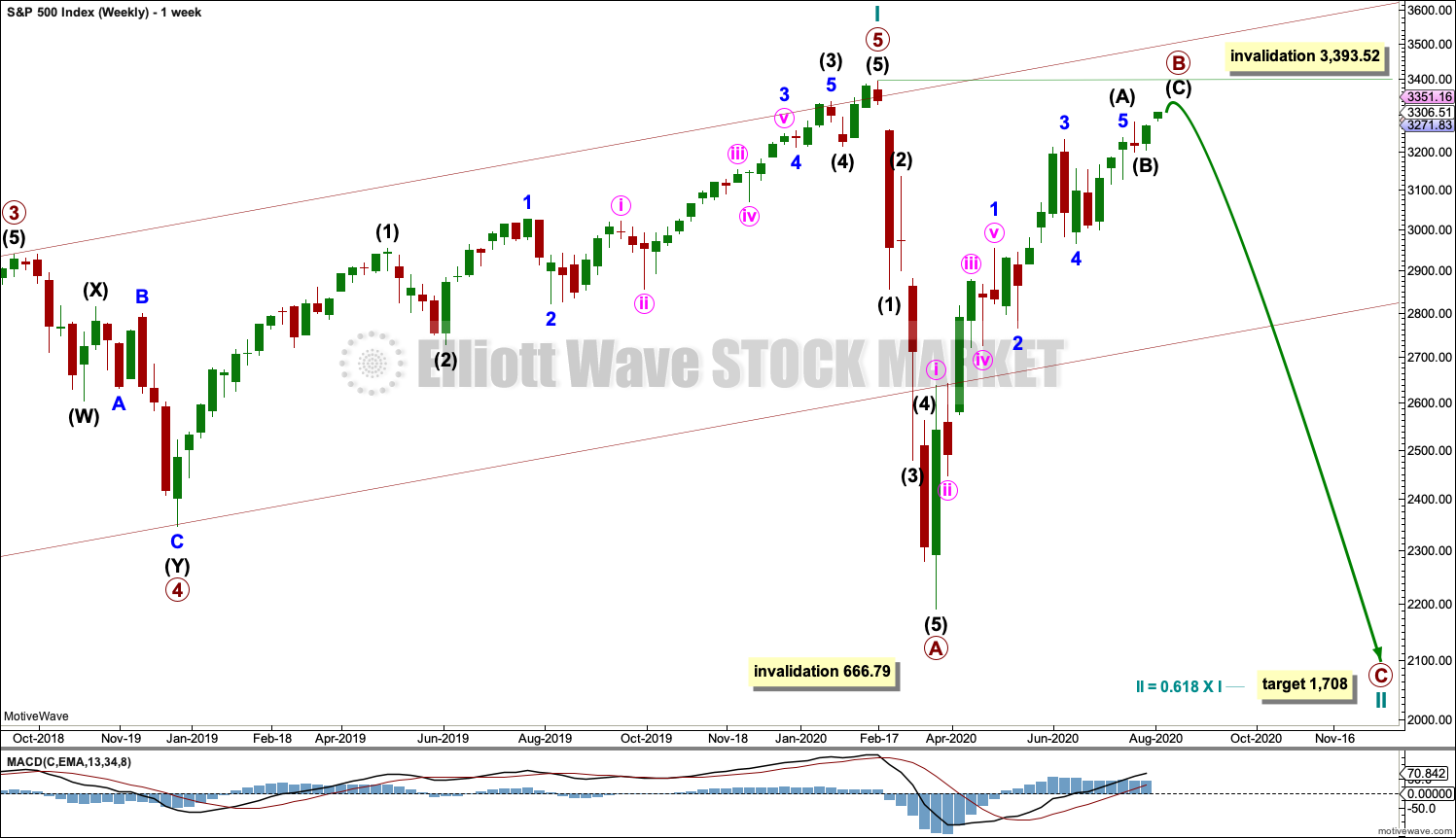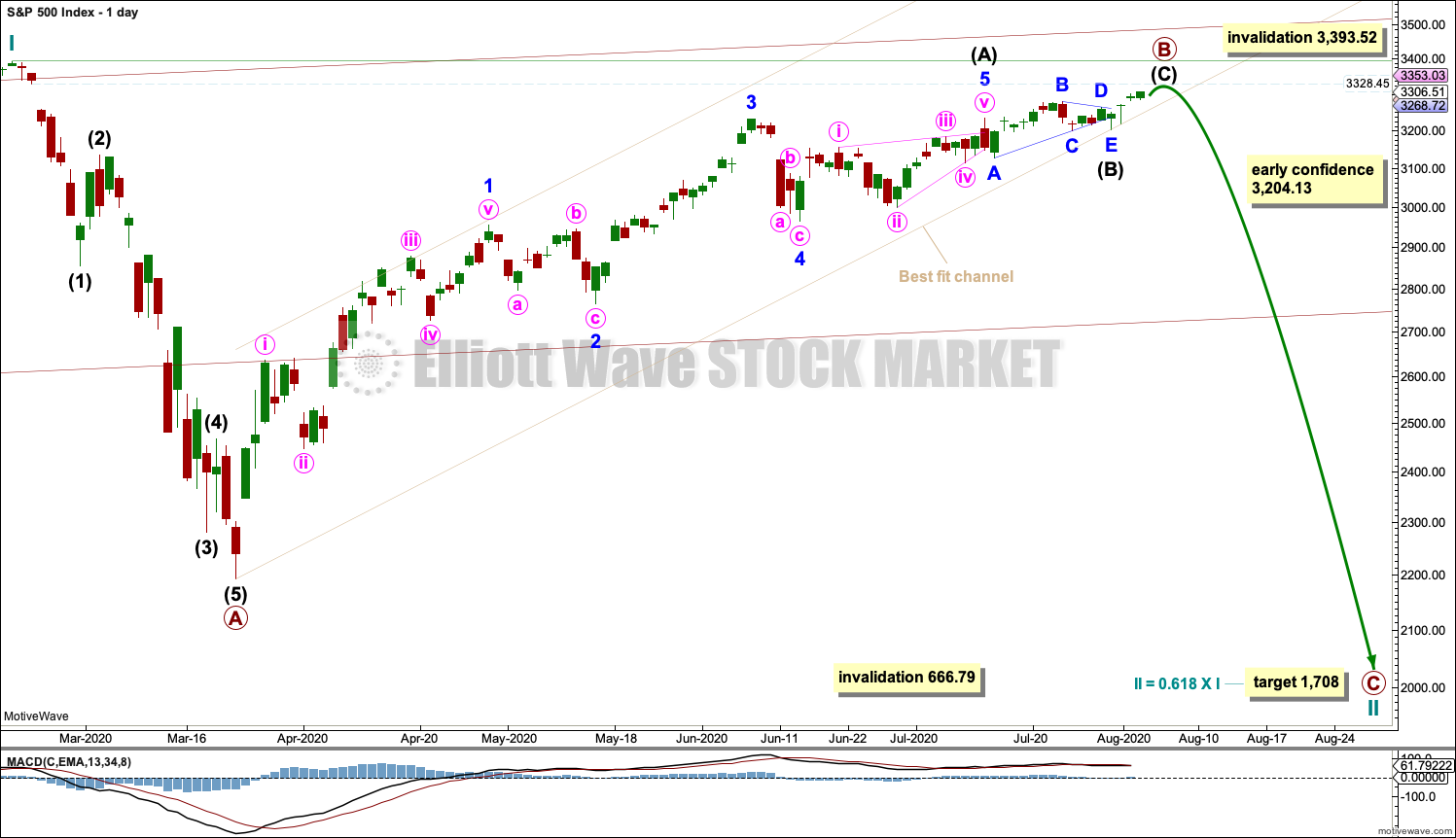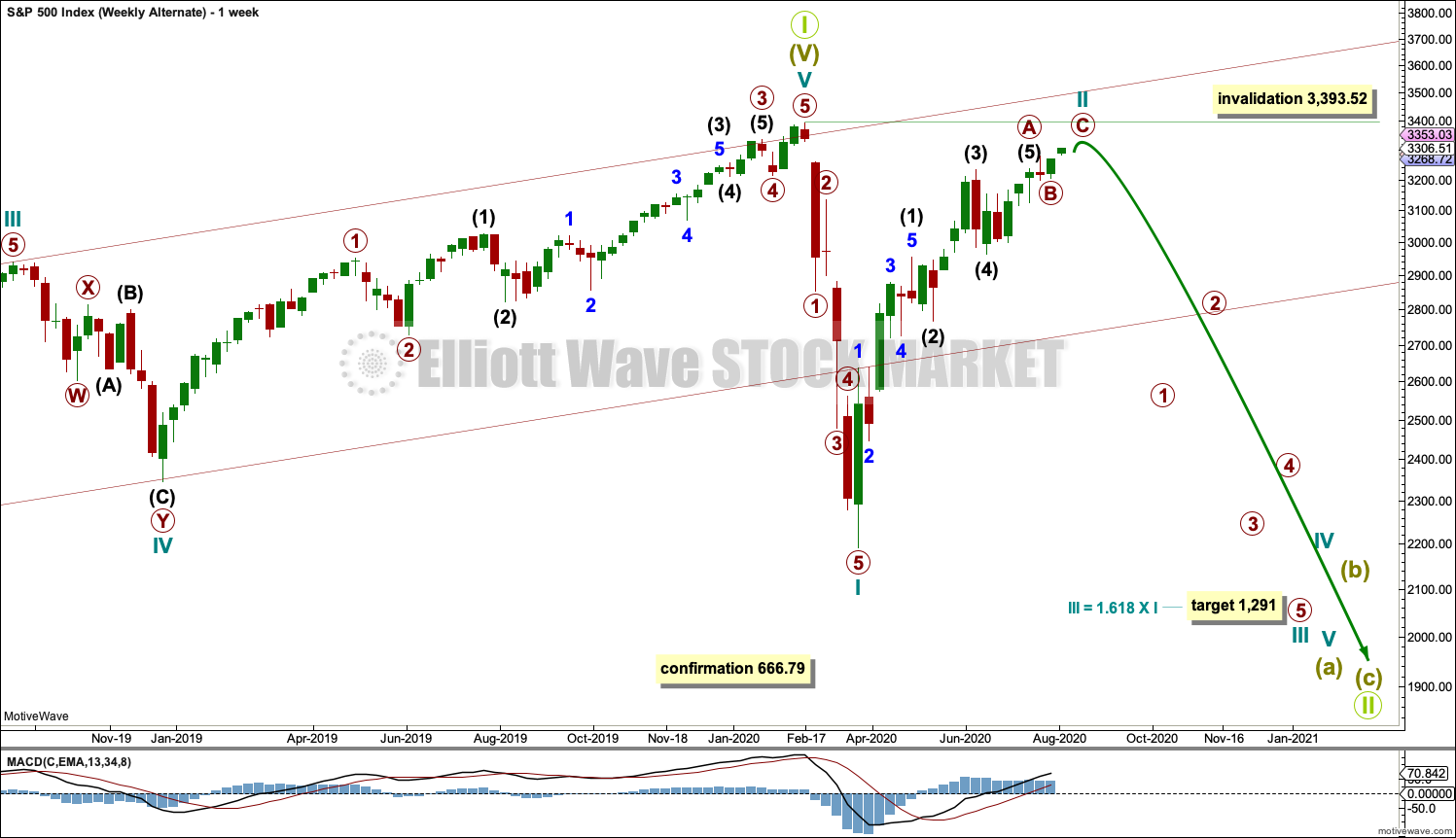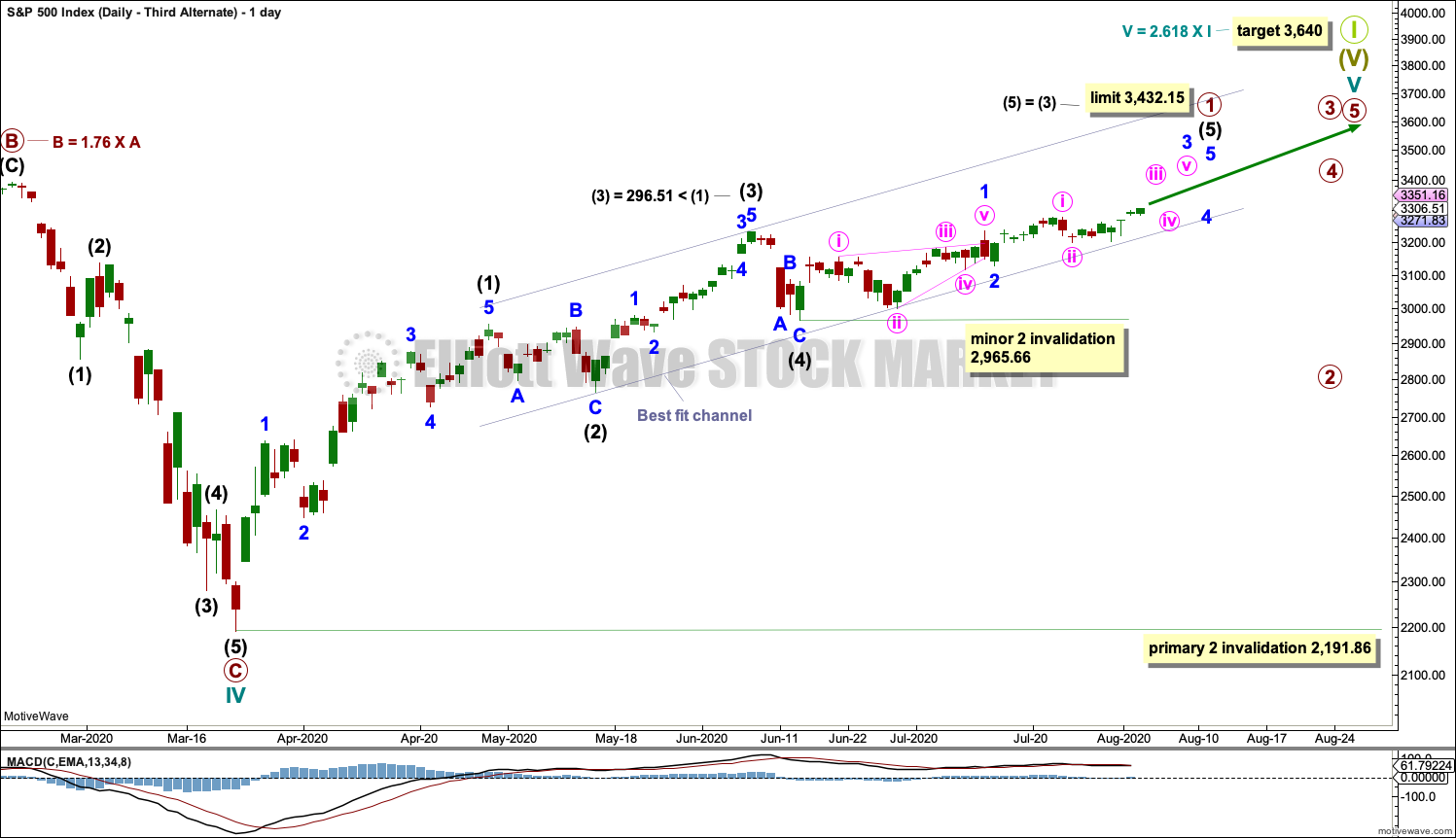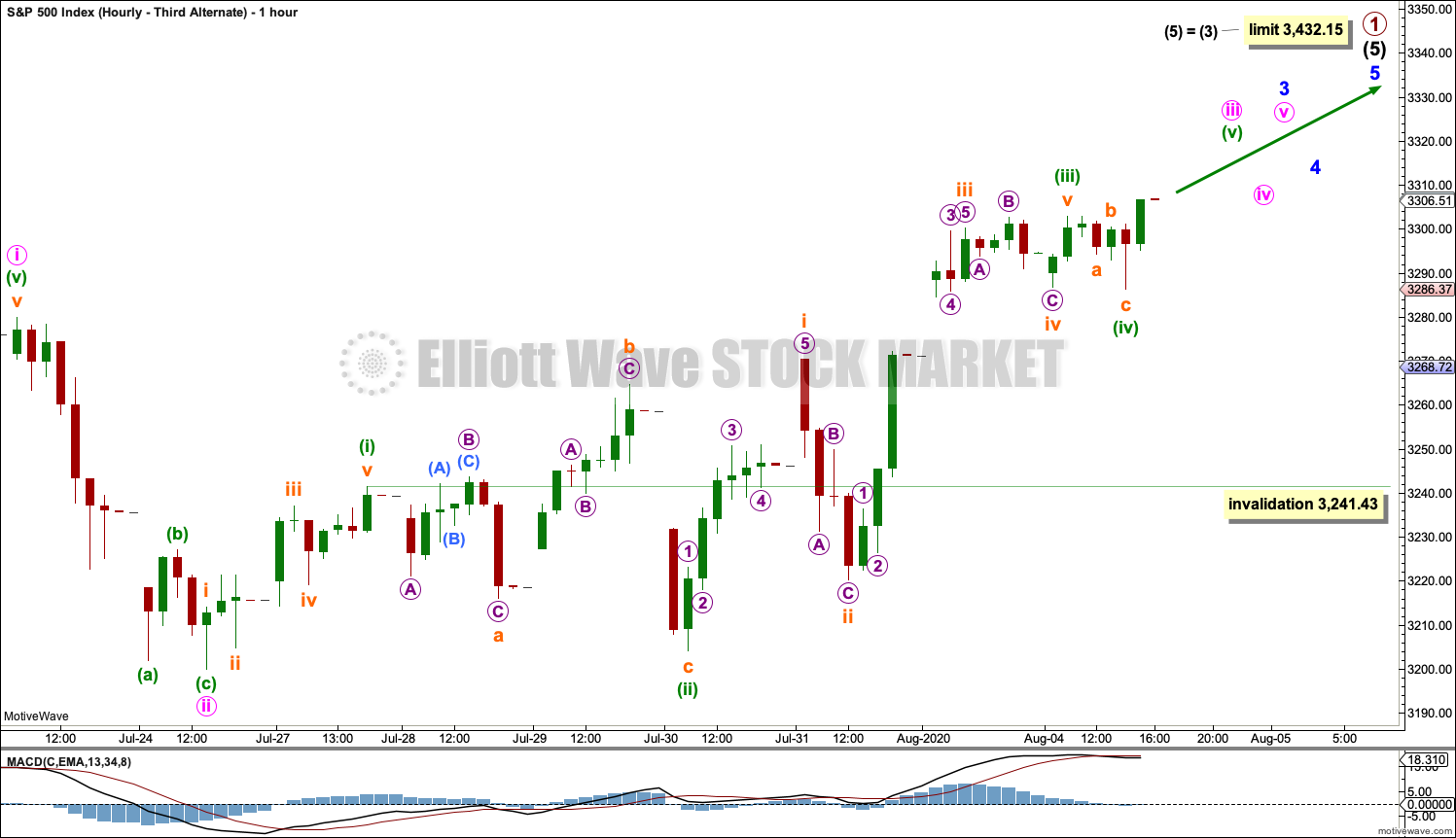S&P 500: Elliott Wave and Technical Analysis | Charts – August 4, 2020
Price continues to move higher towards the classic analysis target calculated from a small bull flag pattern. The short-term alternate Elliott wave count is now the main Elliott wave count.
Summary: A short-term target for this bounce to end is now at 3,311. This target may now be met quite quickly, either this week or possibly next week.
A bearish candlestick reversal pattern would indicate a high in place.
Price broke above small bullish flag pattern on Friday. A short-term classic analysis target would be at 3,405. This fits the bullish alternate Elliott wave count, which now has some support from classic technical analysis and should be seriously considered. A new high above 3,393.52 would provide confidence in this wave count. A new high above 3,328.45 would increase probability of a bullish wave count.
The biggest picture, Grand Super Cycle analysis, is here.
Last monthly charts are here. Video is here.
ELLIOTT WAVE COUNTS
MAIN WEEKLY CHART
This main Elliott wave count expects that the bull market beginning in March 2009 was cycle wave I of Super Cycle wave (V). The trend change in February 2020 may have been only at cycle degree. Cycle wave II may last from one to a few years.
Cycle wave II would most likely subdivide as a zigzag; thus far that looks like what is unfolding. Primary wave B may be now very close to completion. It may end this week or possibly next week. When primary wave B may again be complete, then a second target would again be calculated for primary wave C to end cycle wave II.
Cycle wave II may not move beyond the start of cycle wave I below 666.79.
DAILY CHART
Draw the wide maroon trend channel carefully: draw the first trend line from the end of primary wave 1 at 2,093.55 (December 26, 2014), to the end of primary wave 3 at 2,940.91 (September 21, 2018), then place a parallel copy on the end of primary wave 2 at 1,810.10 (February 11, 2016). The channel was fully breached in March 2020 indicating a trend change from the multi-year bull trend to a new bear trend. During the next downwards wave this line may offer some support.
Cycle wave II may subdivide as any Elliott wave corrective structure except a triangle. It would most likely be a zigzag (zigzags subdivide 5-3-5).
Minor wave A may have ended on the 13th of July with an ending contracting diagonal for minor wave 5, followed by a running contracting triangle for intermediate wave (B).
Primary wave B may now be an incomplete single zigzag.
If primary wave A is correctly labelled as a five wave impulse, then primary wave B may not move beyond the start of primary wave A above 3,393.52.
HOURLY CHART
Intermediate wave (C) must subdivide as a five wave motive structure, most likely an impulse.
Minor waves 1 through to 4 within the impulse of intermediate wave (C) may now be complete. On the five minute chart, minor wave 5 may need only one more small upwards wave to complete it. Intermediate wave (C) may be over now at any time.
A new low now below the start of intermediate wave (C) at 3,204.13 could not be a second wave correction within intermediate wave (C), so at that stage intermediate wave (C) would have to be over. A new low below 3,204.13 would provide some confidence that a high may be in place.
FIRST ALTERNATE WEEKLY CHART
This alternate weekly chart follows the First Alternate Monthly chart. It is best viewed on a weekly chart time frame.
By simply moving the degree of labelling in the bull market beginning March 2009 up one degree, it is possible that a Grand Super Cycle trend change occurred on February 19, 2020. The bull market from March 2009 to February 2020 may have been a complete fifth wave labelled Super Cycle wave (V).
A bear market at Grand Super Cycle degree may be expected to last at least a decade, possibly longer. Corrections for this market tend to be much quicker than bullish moves, and so a fair amount of flexibility is required in expectations for duration of the different degrees.
Grand Super Cycle II would most likely subdivide as a zigzag, although it may be any corrective structure except a triangle. It should begin with a five down at the weekly chart time frame, which would be incomplete.
The first wave down on the daily chart is labelled cycle wave I. If this degree of labelling is wrong, it may be too high; it may need to be moved down one degree.
Following cycle wave I, cycle wave II may be an incomplete single zigzag.
If it continues any higher, then cycle wave II may not move beyond the start of cycle wave I above 3,393.52.
THIRD ALTERNATE DAILY CHART – BULLISH
This alternate daily chart follows the third alternate monthly chart. It will be published daily because the structure of the current upwards wave is different and so the invalidation point is different. This alternate chart labels the subdivisions of the long bull market differently.
The target for the end of this bull market is provisional. It would best be calculated at primary degree, but that cannot be done until all of primary waves 1 through to 4 are complete. At that stage, the target will be recalculated and will very likely change.
Cycle wave V must subdivide as a five wave motive structure, most likely an impulse. Primary wave 1 within cycle wave V may be nearing completion.
Within primary wave 1: intermediate waves (1) through to (4) may be complete.
The channel drawn about primary wave 1 using Elliott’s technique was no longer showing where price was finding support. The channel is redrawn as a best fit. While intermediate wave (5) continues higher, along the way smaller corrections may find support about the lower edge of this channel. A breach of this channel at this stage may indicate an end to primary wave 1.
Intermediate wave (3) within primary wave 1 is shorter than intermediate wave (1). Because intermediate wave (3) may not be the shortest actionary wave, intermediate wave (5) is limited to no longer than equality in length with intermediate wave (3) at 3,432.15.
When primary wave 1 may be a complete five wave structure, then primary wave 2 should then unfold as a multi-week pullback and may not move beyond the start of primary wave 1 below 2,191.86.
This alternate wave count is bullish.
Bearish divergence between price and inverted VIX and RSI do not support this wave count. Weak volume does not support this wave count.
Cycle wave V may last from one to several years.
THIRD ALTERNATE HOURLY CHART
The hourly chart focusses on the middle of minor wave 3 from the end of minute waves i and ii within it.
This wave count now expects that minor wave 3 may have moved through the middle strongest portion. Minuette wave (iv) may not move into minuette wave (i) price territory below 3,241.43.
Minor wave 3 should exhibit strength.
TECHNICAL ANALYSIS
WEEKLY CHART

Click chart to enlarge. Chart courtesy of StockCharts.com.
An inside week completes with some increase in volume for upwards movement within it. This is bullish at least for the short term. There is no bearish reversal pattern.
DAILY CHART
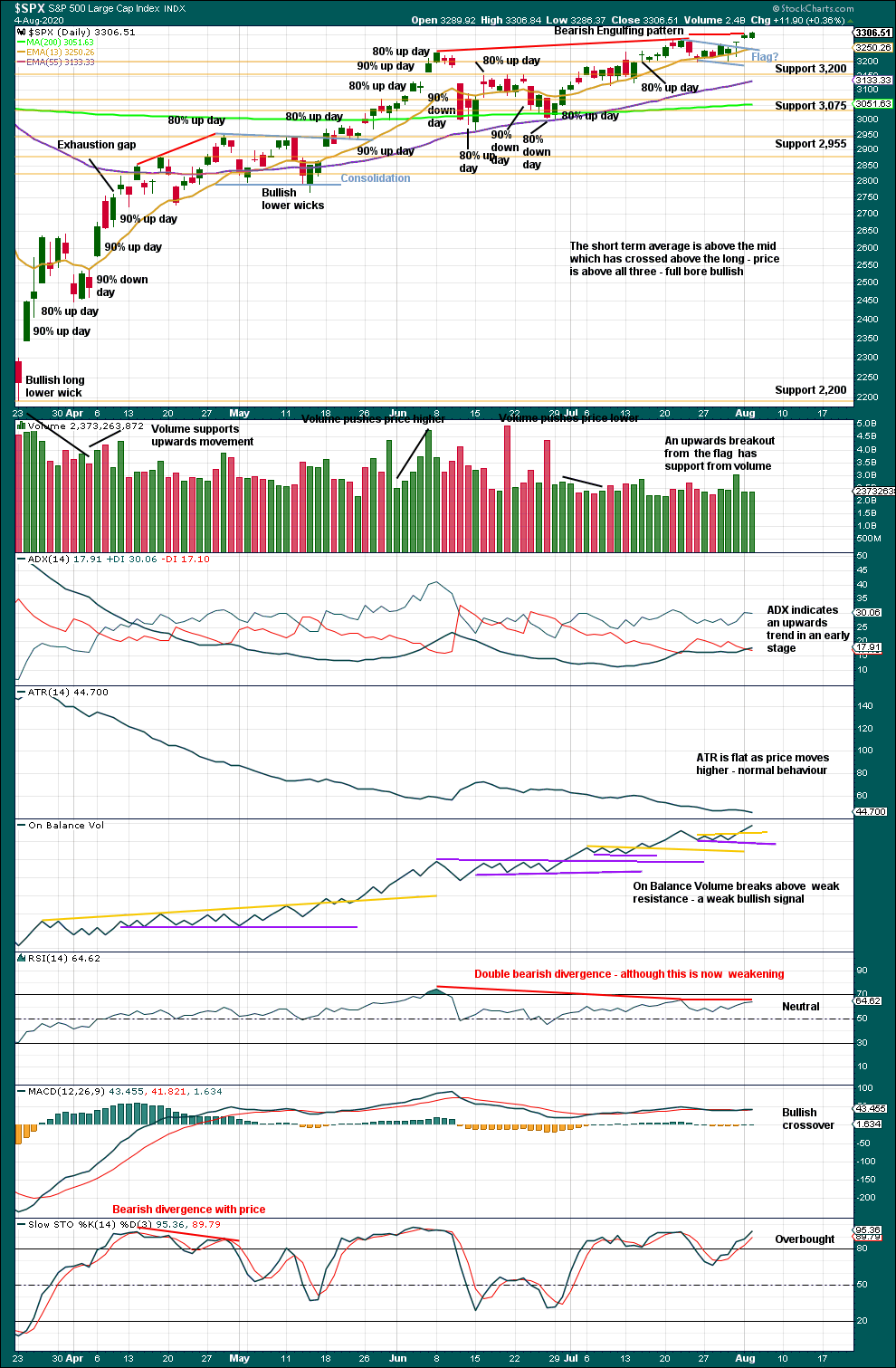
Click chart to enlarge. Chart courtesy of StockCharts.com.
The breakaway gap of 24th February has its upper edge at 3,328.45. A bearish analysis remains reasonable while this gap remains open. If this gap is closed, then a more bullish analysis that would expect new all time highs would increase in probability.
Friday completed an upwards breakout from a small flag pattern that has support from volume. A target from the flag pole would be at 3,405. This supports the third alternate bullish Elliott wave count.
There is still double bearish divergence between price and RSI, although today this is weakening. Sometimes bearish divergence between price and RSI disappears as price continues higher, but more often it is an indication of weakness prior to a trend change.
Volume is light, but this has long been a characteristic of this market since 2009; price has been able to rise on light and declining volume for many years now. RSI and ADX are not extreme; there is room for upwards movement to continue.
BREADTH – AD LINE
WEEKLY CHART
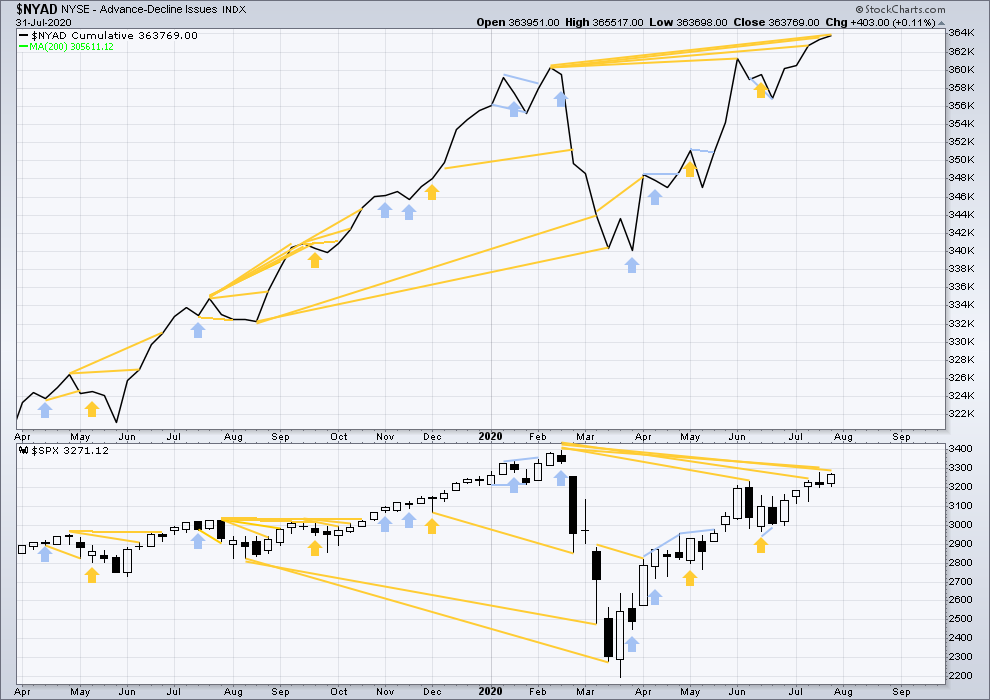
Click chart to enlarge. Chart courtesy of StockCharts.com. So that colour blind members are included, bearish signals will be noted with blue and bullish signals with yellow.
Breadth should be read as a leading indicator.
Last week the NYSE all issues AD line has made another new all time high, although Lowry’s Operating Companies Only AD line still has not. This divergence is bullish and noted on this chart, but failure of the OCO AD line to confirm this divergence reduces the strength of the signal.
Large caps all time high: 3,393.52 on 19th February 2020.
Mid caps all time high: 2,109.43 on 20th February 2020.
Small caps all time high: 1,100.58 on 27th August 2018.
Again, at the end of last week, it is only large caps that have made new swing highs above the prior high of the 8th of June. Small and mid caps have not. The rise over the last several weeks is led by large caps, so it lacks breadth. This is normal of an aged bullish move and supports the main Elliott wave count.
DAILY CHART
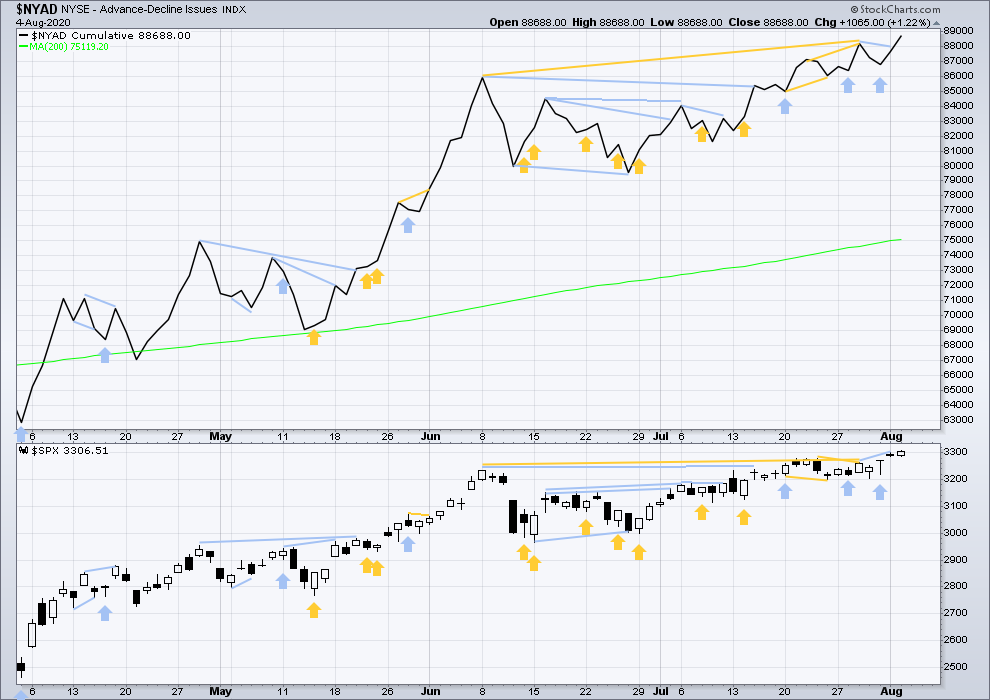
Click chart to enlarge. Chart courtesy of StockCharts.com. So that colour blind members are included, bearish signals will be noted with blue and bullish signals with yellow.
Short-term bearish divergence has not been followed by downwards movement, so it may have failed or it may yet be an early indicator of a trend change.
Today both price and the AD line have made new short-term highs. There is no new divergence.
VOLATILITY – INVERTED VIX CHART
WEEKLY CHART
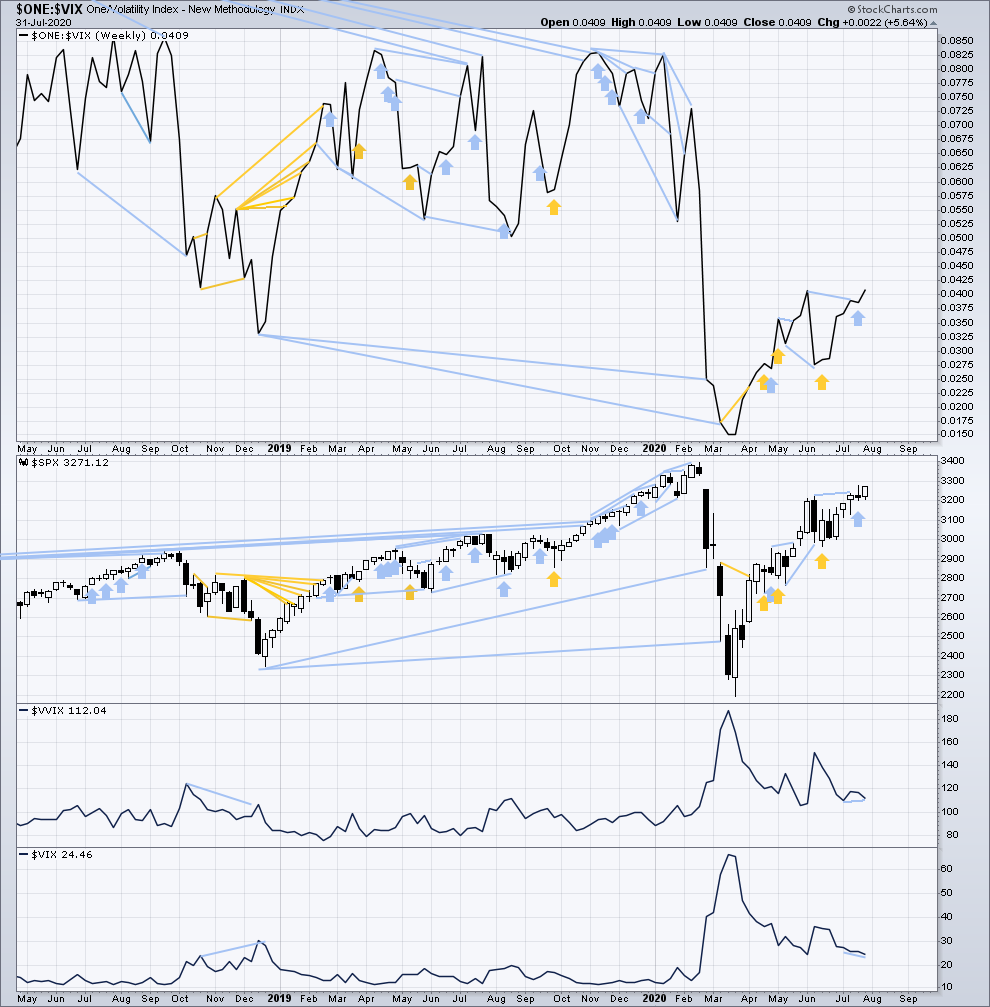
Click chart to enlarge. Chart courtesy of StockCharts.com. So that colour blind members are included, bearish signals will be noted with blue and bullish signals with yellow.
Inverted VIX remains well below all time highs. There remains over two years of strong bearish divergence between price and inverted VIX.
Last week both price and inverted VIX have moved higher. There is no new divergence.
Comparing VIX and VVIX: For the very short term, from weeks beginning 6th to 27th July, price has moved higher and VIX has declined; this is normal. But VVIX has not made a new short-term low and remains slightly elevated. This divergence is bearish for the short term.
DAILY CHART
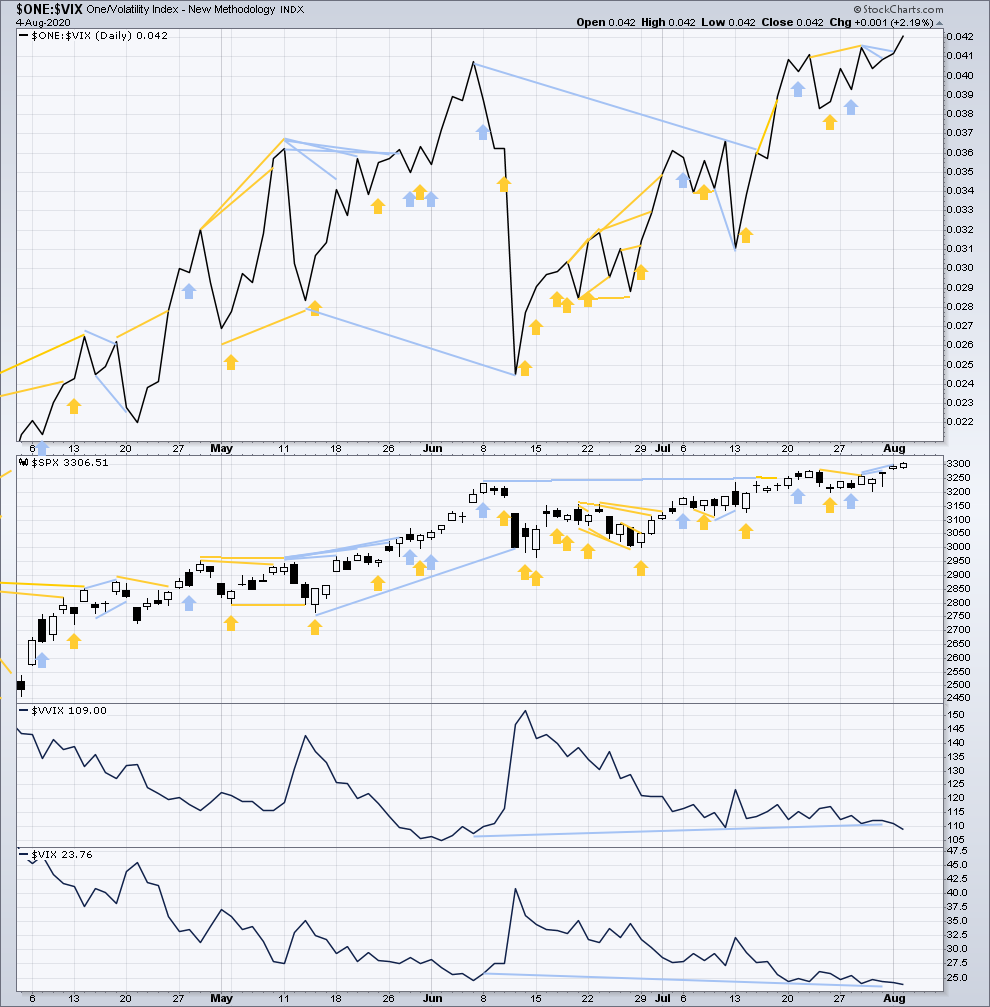
Click chart to enlarge. Chart courtesy of StockCharts.com. So that colour blind members are included, bearish signals will be noted with blue and bullish signals with yellow.
Short-term bearish divergence has not been followed by downwards movement, so it may have failed or it may yet be an early indictor of a trend change.
Today both price and inverted VIX have made new short-term highs. There is no new divergence.
DOW THEORY
Dow Theory has confirmed a bear market with the following lows made on a closing basis:
DJIA: 21,712.53 – a close below this point has been made on the March 12, 2020.
DJT: 8,636.79 – a close below this point has been made on March 9, 2020.
Adding in the S&P and Nasdaq for an extended Dow Theory, a bear market has now been confirmed:
S&P500: 2,346.58 – a close below this point has now been made on March 20, 2020.
Nasdaq: 7,292.22 – a close below this point was made on the March 12, 2020.
At this time, to shift Dow Theory from viewing a bear market to confirmation of a new bull market would require new highs made on a closing basis:
DJIA – 29,568.57
DJT – 11,623.58
Adding in the S&P and Nasdaq for an extended Dow Theory:
S&P500 – 3,393.52
Nasdaq – 9,838.37 – closed above on June 8, 2020.
Additionally, neither of DJIA nor DJT have made new swing highs above the prior highs of 8th of June. Only S&P500 and Nasdaq have made mid-term swing highs.
Published @ 06:32 p.m. ET
—
Careful risk management protects your trading account(s).
Follow my two Golden Rules:
1. Always trade with stops.
2. Risk only 1-5% of equity on any one trade.
—
New updates to this analysis are in bold.

